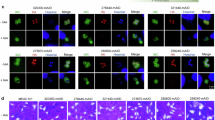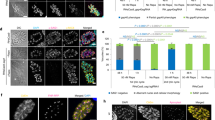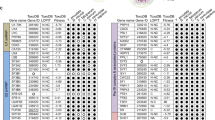Abstract
ATP-dependent chromatin remodellers are specialized multiprotein machines that organize the genome in eukaryotic cells and regulate its accessibility by repositioning, ejecting or modifying nucleosomes. However, their role in Toxoplasma gondii is poorly understood. Here we show that T. gondii has evolved two divergent proteins within the imitation switch (ISWI) family: TgSNF2h and TgSNF2L. TgSNF2h specifically forms a core complex with the transcription factor AP2VIII-2 and the scaffold protein TgRFTS. Depletion of TgRFTS phenocopies the knockdown of TgSNF2h, restricting access to chromatin and altering local gene expression. At the genomic level, TgSNF2h insulates highly transcribed genes from silenced neighbours, ensuring stage-specific gene regulation. By modulating chromatin accessibility to transcription factors, TgSNF2h exerts epistatic control over MORC, a key regulator of sexual commitment. Our findings show that a specific ISWI complex orchestrates the partitioning of developmental genes and ensures transcriptional fidelity throughout the parasite life cycle.
This is a preview of subscription content, access via your institution
Access options
Access Nature and 54 other Nature Portfolio journals
Get Nature+, our best-value online-access subscription
$32.99 / 30 days
cancel any time
Subscribe to this journal
Receive 12 digital issues and online access to articles
$119.00 per year
only $9.92 per issue
Buy this article
- Purchase on SpringerLink
- Instant access to full article PDF
Prices may be subject to local taxes which are calculated during checkout






Similar content being viewed by others
Data availability
Correspondence and requests for materials should be addressed to M.-A.H. Nanopore and Illumina RNA-seq data that support the findings of this study have been deposited to the GEO datasets under accession number GSE271902. The ChIP-seq and ATAC-seq data have been deposited to the GEO datasets under accession numbers GSE271900 and GSE271901, respectively. The MS proteomics data have been uploaded to the ProteomeXchange Consortium through the PRIDE partner repository with the dataset identifier PXD056911 for the interactome analyses. Processed proteomics data are available in Supplementary Table 1. Source data are provided with this paper.
References
Flaus, A. et al. Identification of multiple distinct Snf2 subfamilies with conserved structural motifs. Nucleic Acids Res. 34, 2887–2905 (2006).
Zhou, C. Y. et al. Mechanisms of ATP-dependent chromatin remodeling motors. Annu. Rev. Biophys. 45, 153–181 (2016).
Clapier, C. R. & Cairns, B. R. The biology of chromatin remodeling complexes. Annu. Rev. Biochem. 78, 273–304 (2009).
Narlikar, G. J. et al. Mechanisms and functions of ATP-dependent chromatin-remodeling enzymes. Cell 154, 490–503 (2013).
Blessing, C. et al. Restraining and unleashing chromatin remodelers—structural information guides chromatin plasticity. Curr. Opin. Struct. Biol. 65, 130–138 (2020).
Jungblut, A. et al. Megadalton chromatin remodelers: common principles for versatile functions. Curr. Opin. Struct. Biol. 64, 134–144 (2020).
Lorch, Y. & Kornberg, R. D. Chromatin-remodeling for transcription. Q. Rev. Biophys. 50, e5 (2017).
Eustermann, S. et al. Energy-driven genome regulation by ATP-dependent chromatin remodellers. Nat. Rev. Mol. Cell Biol. 25, 309–332 (2024).
Bougdour, A. et al. Drug inhibition of HDAC3 and epigenetic control of differentiation in Apicomplexa parasites. J. Exp. Med. 206, 953–966 (2009).
Kim, K. The epigenome, cell cycle, and development in Toxoplasma. Annu Rev. Microbiol. 72, 479–499 (2018).
Hollin, T. et al. Epigenetic regulation and chromatin remodeling in malaria parasites. Annu Rev. Microbiol. 77, 255–276 (2023).
Farhat, D. C. et al. A MORC-driven transcriptional switch controls Toxoplasma developmental trajectories and sexual commitment. Nat. Microbiol. 5, 570–583 (2020).
Abramson, J. et al. Accurate structure prediction of biomolecular interactions with AlphaFold 3. Nature 630, 493–500 (2024).
van Kempen, M. et al. Fast and accurate protein structure search with Foldseek. Nat. Biotechnol. 42, 243–246 (2024).
Sidik, S. M. et al. A genome-wide CRISPR Screen in Toxoplasma identifies essential Apicomplexan genes. Cell 166, 1423–1435 (2016).
Loyola, A. et al. Functional analysis of the subunits of the chromatin assembly factor RSF. Mol. Cell. Biol. 23, 6759–6768 (2003).
Min, S. et al. ATM-dependent chromatin remodeler Rsf-1 facilitates DNA damage checkpoints and homologous recombination repair. Cell Cycle 13, 666–677 (2014).
Leonhardt, H. et al. A targeting sequence directs DNA methyltransferase to sites of DNA replication in mammalian nuclei. Cell 71, 865–873 (1992).
White, S. A. et al. The RFTS domain of Raf2 is required for Cul4 interaction and heterochromatin integrity in fission yeast. PLoS ONE 9, e104161 (2014).
Gissot, M. et al. Toxoplasma gondii and Cryptosporidium parvum lack detectable DNA cytosine methylation. Eukaryot. Cell. 7, 537–540 (2008).
Ren, W. et al. Direct readout of heterochromatic H3K9me3 regulates DNMT1-mediated maintenance DNA methylation. Proc. Natl Acad. Sci. USA 117, 18439–18447 (2020).
Barisic, D. et al. Mammalian ISWI and SWI/SNF selectively mediate binding of distinct transcription factors. Nature 569, 136–140 (2019).
Buenrostro, J. D. et al. Transposition of native chromatin for fast and sensitive epigenomic profiling of open chromatin, DNA-binding proteins and nucleosome position. Nat. Methods 10, 1213–1218 (2013).
Abdulhay, N. J. et al. Nucleosome density shapes kilobase-scale regulation by a mammalian chromatin remodeler. Nat. Struct. Mol. Biol. 30, 1571–1581 (2023).
Antunes, A. V. et al. In vitro production of cat-restricted Toxoplasma pre-sexual stages. Nature 625, 366–376 (2024).
Bryant, J. M. et al. Exploring the virulence gene interactome with CRISPR–dCas9 in the human malaria parasite. Mol. Syst. Biol. 16, e9569 (2020).
Chahine, Z. et al. PfMORC protein regulates chromatin accessibility and transcriptional repression in the human malaria parasite, P. falciparum. eLife 12, RP92499 (2024).
Singh, M. K. et al. A Plasmodium falciparum MORC protein complex modulates epigenetic control of gene expression through interaction with heterochromatin. eLife 12, RP92201 (2024).
Contreras, S. M. et al. Architecture, chromatin and gene organization of Toxoplasma gondii subtelomeres. Epigenomes 6, 29 (2022).
Wasmuth, J. D. et al. Integrated bioinformatic and targeted deletion analyses of the SRS gene superfamily identify SRS29C as a negative regulator of Toxoplasma virulence. mBio 3, e00321–12 (2012).
Kim, H. et al. The gene-silencing protein MORC-1 topologically entraps DNA and forms multimeric assemblies to cause DNA compaction. Mol. Cell. 75, 700–710 (2019).
Marunde, M. R. et al. Nucleosome conformation dictates the histone code. eLife 13, e78866 (2024).
Markus, B. M. et al. High-resolution mapping of transcription initiation in the asexual stages of Toxoplasma gondii. Front Cell Infect. Microbiol. 10, 617998 (2021).
Adachi, N. & Lieber, M. R. Bidirectional gene organization: a common architectural feature of the human genome. Cell 109, 807–809 (2002).
Trinklein, N. D. et al. An abundance of bidirectional promoters in the human genome. Genome Res. 14, 62–66 (2004).
Bagchi, D. N. & Iyer, V. R. The determinants of directionality in transcriptional initiation. Trends Genet. 32, 322–333 (2016).
Swale, C. et al. Altiratinib blocks Toxoplasma gondii and Plasmodium falciparum development by selectively targeting a spliceosome kinase. Sci. Transl. Med. 14, eabn3231 (2022).
FastQC. Babraham Bioinformatics www.bioinformatics.babraham.ac.uk/projects/fastqc/ (2023).
Farhat, D. C. et al. A plant-like mechanism coupling m6A reading to polyadenylation safeguards transcriptome integrity and developmental gene partitioning in Toxoplasma. eLife 10, e68312 (2021).
Jumper, J. et al. Highly accurate protein structure prediction with AlphaFold. Nature 596, 583–589 (2021).
Mirdita, M. et al. ColabFold: making protein folding accessible to all. Nat. Methods 19, 679–682 (2022).
Pettersen, E. F. et al. UCSF ChimeraX: structure visualization for researchers, educators, and developers. Protein Sci. 30, 70–82 (2020).
Acknowledgements
We are grateful to the developers of the ToxoDB.org Genome Resource. ToxoDB and EuPathDB are part of the National Institutes of Health/National Institutes of Allergy and Infectious Diseases (NIH/NIAID)-funded Bioinformatics Resource Center. B.P., D.C.F., M.S., C.C., A.B., C.S. and M.-A.H. were supported by MSD Avenir (Project LatentToxoDiag, DS-2022-0017), the Laboratoire d’Excellence (LabEx) ParaFrap (ANR-11-LABX-0024), Fondation pour la Recherche Médicale (FRM Equipe, EQU202103012571) and the Agence Nationale pour la Recherche (Project ApiNewDrug, ANR-21-CE35-0010-01; Project ApiMORCing, ANR-21-CE15-0002-01; and Project Chaires Excellence Biologie Santé_ToxoNeoSex, ANR-24-CHBS-0008). MS-based proteomic experiments (L.B. and Y.C.) were partially supported by Agence Nationale de la Recherche under projects ProFI (Proteomics French Infrastructure, ANR-10-INBS-08) and GRAL, a program from the Chemistry Biology Health Graduate School of University Grenoble Alpes (ANR-17-EURE-0003). We would like to thank I. Khusainov and R. Linares for excellent support in using the EM Facility at EMBL Grenoble.
Author information
Authors and Affiliations
Contributions
M.-A.H. and C.S. supervised the research and coordinated the collaboration. B.P., D.C.F., M.S., J.v.V., C.C., C.M., M.W.B., A.B., C.S. and M.-A.H. designed, performed and interpreted the experimental work. Y.C., L.B. and P.-J.d.B. performed the MS-based proteomic analyses. M.-A.H. wrote the paper with editorial support from C.S. and B.P. and comments from all other authors.
Corresponding authors
Ethics declarations
Competing interests
The authors declare no competing interests.
Peer review
Peer review information
Nature Microbiology thanks Luisa Figueiredo, T. Nicolai Siegel and the other, anonymous, reviewer(s) for their contribution to the peer review of this work.
Additional information
Publisher’s note Springer Nature remains neutral with regard to jurisdictional claims in published maps and institutional affiliations.
Extended data
Extended Data Fig. 1 T. gondii ISWI-family remodelers and their partners.
Schematic representation of TgSNF2L (top) and TgSNF2h (bottom) and their respective partners. Structures of the domains were predicted using AlphaFold v2. Coordinates and pLDDT values for selected amino acid residues are indicated. Disorder scores, ranging from 0 (fully ordered) to 1 (fully disordered), were obtained using IUPred2.
Extended Data Fig. 2 Comparison of RFTS domain containing proteins.
a. Illustration representing the domain architectures of RFTS domain containing proteins. b. Superposed cartoon representation of secondary structures of the RFTS domain of TgRFTS (red) and SpRAF2 (blue) obtained using AlphaFold v2. pLDDT score for each protein is indicated on the top right and RMSD score on the bottom right corner.
Extended Data Fig. 3 mAID-based inducible KD system successfully depleted TgSNF2h, TgSNF2L and TgRFTS.
Depletion of TgSNF2L-mAID-HA (a-c) and TgSNF2h-mAID-HA (d-f) upon addition of IAA for 24 hours was monitored by IFA. Fixed and permeabilized parasites were probed with HA (red) to detect TgSNF2h- or TgSNF2L-mAID-HA and co-stained with GAP45 (green). After 24 hours of protein depletion, parasites displayed aberrant morphology (a and d). Violin plots quantify nuclear HA signal in IFA after IAA addition (100 nuclei per condition); statistical significance was determined using one-way ANOVA and Tukey’s test (b and e). Complete protein loss after 5 hours of IAA treatment was confirmed via Western blot analysis of whole-cell extracts, using HA for detection and HDAC3 as a loading control (c and f). g. Depletion of TgRFTS protein using the mAID system after IAA addition was measured by IFA. Fixed and permeabilized parasites were probed with HA (red) to detect TgRFTS-mAID-HA. h. Violin plots quantify nuclear HA signal in IFA after IAA addition (100 nuclei per condition); statistical significance was determined using one-way ANOVA and Tukey’s test. i. The effects of conditional depletion of TgSNF2L, TgSNF2h, and TgRFTS on the lytic cycle were determined by plaque assay. 500 parasites were grown for 7 days in the presence or absence of IAA. No plaques were obtained after IAA addition, confirming that both remodelers and TgRFTS protein are essential for T. gondii's asexual in vitro growth. The area of all plaques was measured to create violin plots, and statistical significance was evaluated using P values from unpaired Student’s t-tests.
Extended Data Fig. 4 Unlike TgSNF2L, TgSNF2h promotes chromatin access for HDAC3/MORC and modulates gene expression across developmental stages.
a. The heat map, generated using iDEP.96 with mean-centered, log2-transformed data and k-means clustering (Pearson correlation), reveals gene expression patterns across in vivo stages -merozoites, enteroepithelial stages (EESs) 1 to 5, tachyzoites, sporozoites, and cysts25. Patterns in in vitro MORC KD12, TgSNF2h KD, and TgRFTS and TgSNF2L KD are also shown. Transcript abundance, displayed as log2[FC] from log-transformed mean TPM of three replicates, highlights upregulation (magenta) and downregulation (green). b. Heat map and profile analysis display ChIP peak intensities for TgSNF2L and HDAC3 in untreated (UT) and TgSNF2L-depleted parasites. K-means clustering in the UT sample shows enrichment of TgSNF2L and HDAC3 at TSS in cluster 1 genes with a significant spreading of TgSNF2L upstream and downstream. c. Venn diagram compares TgSNF2L/TgSNF2h promoter peaks, clustered by TSS-centered ChIP-seq signals. d. IGB screenshots display ChIP-seq enrichment for MORC and TgSNF2h after TgSNF2h depletion, alongside HDAC3 and TgSNF2L enrichment following TgSNF2L depletion, with read density shown on the y-axis.
Extended Data Fig. 5 TgSNF2h depletion does not affect MORC binding at telomeres.
a. IGB screenshots of MORC and TgSNF2h ChIP-seq enrichment at chromosomal ends following TgSNF2h depletion, alongside H3K9me3 ChIP-seq in the wild-type strain. Read density is on the y-axis, with telomeric repeats (TTTAGGG) marked. b. IGB view of H3K9me3, MORC, and TgSNF2h ChIP-seq enrichment at the end of chromosome XII following TgSNF2h and MORC knockdowns. Tn5 transposase accessibility peaks and mRNA density from nanopore direct RNA sequencing (DRS) multi-pileup before and after depletion are shown for comparison. A 5-Kb violet square region is amplified on the left to enhance visualization of the telomeric peaks, with telomeric repeats (TTTAGGG) marked on top. c. IFA of TgSNF2h and MORC knockdowns, either left untreated or treated with IAA for 48 hours. Cells were fixed and stained with IMC1 (pink) and co-stained with the DNA-specific Hoechst dye (green).
Extended Data Fig. 6 Loss of TgSNF2h and MORC affect chromatin accessibility and transcriptional outcomes at stage-specific genes.
a. Metagenomic profile and heatmaps of ChIP-seq (right) and Tn5 transposase accessibility (left) for a cluster of sporozoite-specific genes, comparing TgSNF2h KD and MORC KD under untreated (UT) and IAA-treated conditions, similar to Fig. 5c. b. IGB screenshots illustrate representative genomic regions containing sporozoite (SporoSAG, TGME49_227100) and sexual stage-specific genes (PF16), showing ChIP-seq signal occupancy, ATAC-seq chromatin accessibility profiles, and nanopore DRS data under TgSNF2h and MORC knockdowns, similar to Fig. 5d. c. IGB screenshots illustrate genes regulated by bidirectional promoters, showing differential expression after IAA treatment. Shown are ChIP-seq signal occupancy, ATAC-seq chromatin accessibility profiles, and nanopore DRS data under TgSNF2h, MORC and TgSNF2L knockdowns.
Supplementary information
Supplementary Information
Supplementary Figs. 1–3.
Supplementary Table 1
MS data. MS counts of proteins interacting with HA-Flag-tagged TgSNF2L, TgSNF2h, TgRFTS and TgRSF1d.
Supplementary Table 2
ATAC-seq data. Raw counts and TPM values of ATAC-seq data generated in this study.
Supplementary Table 3
RNA-seq data: Illumina and Nanopore. Raw counts and TPM values of RNA-seq data generated in this study.
Supplementary Table 4
Peaks detected by MACS. Statistically significant ChIP-enriched regions (peaks) detected by MACS were identified by IP, using a P value threshold of 1 × 10−4. The Excel/BED format file containing the ChIP-enriched regions was generated for each sample.
Supplementary Table 5
Description of T. gondii strains and molecular biology reagents. List of T. gondii parasite lines as well as plasmids used in this work. Primers and DNA synthesis construct used in this work are also charted in the table.
Source data
Source Data Fig. 2
Unprocessed western blots and stained gels.
Source Data Fig. 2
Statistical source data.
Source Data Fig. 3
Statistical source data.
Source Data Fig. 6
BioRender license.
Source Data Extended Data Fig. 3
Statistical source data.
Source Data Extended Data Fig. 3
Unprocessed western blots.
Rights and permissions
Springer Nature or its licensor (e.g. a society or other partner) holds exclusive rights to this article under a publishing agreement with the author(s) or other rightsholder(s); author self-archiving of the accepted manuscript version of this article is solely governed by the terms of such publishing agreement and applicable law.
About this article
Cite this article
Pachano, B., Farhat, D.C., Shahinas, M. et al. An ISWI-related chromatin remodeller regulates stage-specific gene expression in Toxoplasma gondii. Nat Microbiol 10, 1156–1170 (2025). https://doi.org/10.1038/s41564-025-01980-2
Received:
Accepted:
Published:
Issue date:
DOI: https://doi.org/10.1038/s41564-025-01980-2
This article is cited by
-
Regulation of the developmental programs in Toxoplasma by a novel SNF2L-containing chromatin remodeling complex
Nature Communications (2025)
-
Uncovering biomarkers for chronic toxoplasmosis detection highlights alternative pathways shaping parasite dormancy
EMBO Molecular Medicine (2025)



